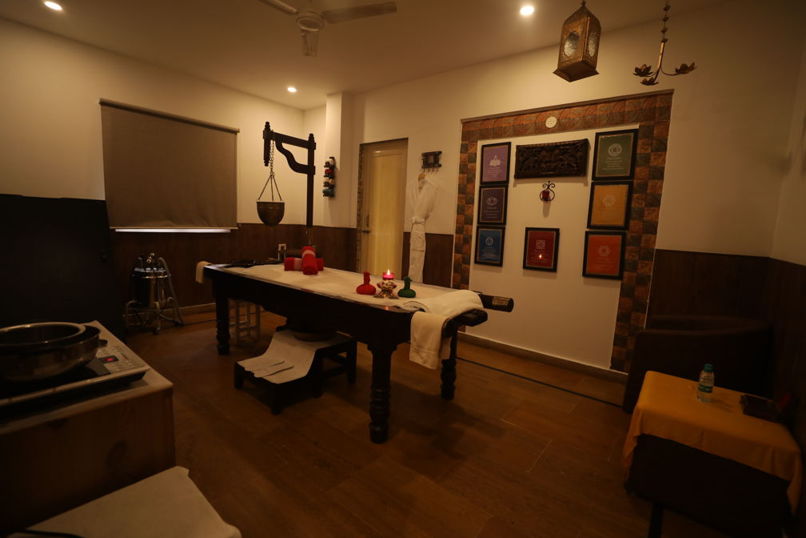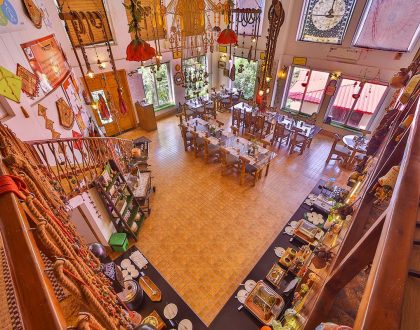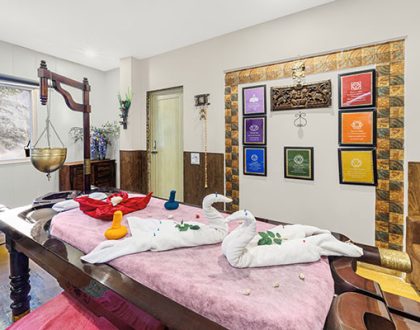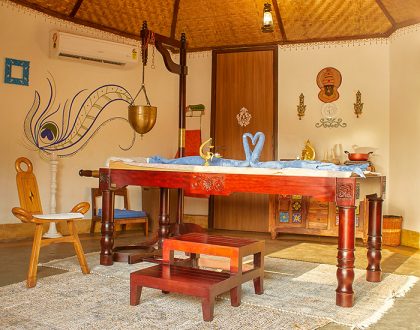Ayurvedic Cure For Musculoskeletal Disorders in Rishikesh

Ayurvedic Cure For Musculoskeletal Disorders By Veda5, The Best Ayurveda & Panchakarma Retreat in Rishikesh, India
Pain is a commonly occurring problem that is particularly prevalent in older adults. Persistent pain may by the result of musculoskeletal conditions, neuropathic conditions trauma or limb amputation. Surgery and other invasive procedures or therapies are also associated with pain, as are various psychological conditions.
Musculoskeletal disorders include typical ailments like Rheumatoid Arthritis (RA), Ankylosing Spondylitis (AS), Cervical Spondylosis (CS), Osteoarthritis (OA) and Lower back pain (LBA) by example. Lower back pain (Katishoola) is a disease characterized with pain in the lumbar region. It is a disorder with a variety of causes, occurring in many groups of the population.
A clear description regarding the samprapti (acquisition) and lakshana (indications) of Katishoola is explained by the Shodhala in Kayachikitsa Khanda Vataroga Adhikara. Thus, a variety of disorders have become very common, among which Lower Backache is the most common, resulting from improper posture over lengths of time while sitting. Alteration of an individual’s biological clock by inconsistent sleep patterns and stress may also be considered as important factors in the development of backache. Ayurveda, with its rich tradition and remedies may provide a solution for such ailments.
Introduction
Kati shoola (Lower back pain) is a disease which is mainly caused by vitiation or reduction of Vata dosha. Some ancient texts also describe Kati shoola as a symptom of some disorders such as Katigraha (stiffness).
Sometimes due to pain originating in the lower back, thighs and legs that radiates into the buttocks, visible indications can be identified like muscle spasm, leg pain or weakness, tight hamstring muscles, and irregular gait. This condition can be correlated with Kati shoola (Low back pain).
Four types of pain can be identified:
Local, Referred, Redicular and rising from Secondary Muscular Spasm.
Local Pain
It is caused by any pathologic process that impinges upon, or irritates sensory nerve endings. Local pain is often described as steady and sometimes intermittent, varying considerably with position or activity. The pain may be sharp or dull and although often diffuse is always felt in, or near the affected part of the spine. This is found in conditions like destruction of vertebral bodies due to fracture, tears and distortions of periosteum, synovial membrane, muscle etc.
Referred Pain
It is of two types, the first is projected from the spines into regions lying within the lumbar area and upper sacral dermatomes. The second is from projected abdominal viscera to the spine and, occasionally, tends to be superficially projected.
Redicular or “Root” Pain
Although this type of pain has some of the characteristics of referred pain, it differs in its greater intensity, distal radiation and factors that excite it. The mechanism is distortion, stretching, irritation or compression of the spinal root, most often central to the intervertebral foramen. A common example is the pain occurring in Sciatica.
Pain Resulting From Muscular Spasm
Muscle spasm may be associated with many disorders of spine and can produce significant distortions of the normal posture. Chronic tension in muscles may give rise to dull aching sensations and sometimes cramping.
Causes of Lower Back Pain
- Pelvic inflammatory disease (PID)
- Slipped disc (Herniated)
- Sciatica
- Kidney stones
- Spinal stenosis
- Prostatitis
- Pre-menstrual syndrome (PMS)
- Spinal cord abscess
- Endometriosis
- Ankylosing spondylitis
- Scoliosis
- Sprains and strains etc.
Ayurvedic Regimen for the Management of Low Back Pain and other Musculoskeletal Abnormalities
Ayurvedic Regimen may be broadly divided into three major groups namely Ahara (diet) Vihara (lifestyle) and Aushadhi (medical treatment).
Ahara (Diet)
In shrimadbhagvatgeeta (ch17/8-10), Ahara is classified as Sattvika, Rajasika and Tamsika type. The diet which most of the working individuals consume now a days contains spices, fries, tea, coffee, and junk food. This type of diet indicates the Rajasika Ahara and following such a diet will ultimately vitiate Vata dosha.
The vitiated Vata will give rise to a variety of painful musculoskeletal disorders in the body including lower back pain. Therefore, the diet must be balanced and should contain cereals, pulses milk, fruits and vegetables as required.
Vihara (Lifestyle)
It is importance to maintain a proper sleep-wake cycle and follow all fundamental measures to keep the biological clock of our body working in an optimal level. However, workers at call centre are active physically or mentally for 24 hrs or longer, grossly interfering with their biological clock. This produces mental and physical stress that will ultimately manifest in the form of muscular stiffness and pain in the body.
Lengthy exposure to that kind of Vihara may lead to the development of pain that is chronic in nature, leaving the body susceptible to intensified weakness and pain in old age, if not treated or corrected in a timely manner. Ayurveda doctors provide guidance and mentoring towards the adjustment or correction of improper lifestyles, which help to amplify the best effects and benefits of Aushadhi Chikitsa to the body.
Aushadhi Chikitsa (Medical Treatment)
This is naturally the most important among the management of back pain. In common scenarios, a person may ignore the problem until it worsens to the point that medical intervention becomes a necessity. Variety of medicines are recommended depending on the etiological factors, but there are certain common ingredients which are useful and effective in the treatment of back pain.
Ashwagandha (Withania somnifera) In ayurveda this is considered as balya (tonic). Though it has many other properties like anti-stress, anti-arthritic, muscle relaxant and adaptogenic, its therapeutic preparations range from tablets, capsules, powder, to syrup and avaleha etc., and may be used as required.
Bala (Sida cordifolia): This acts as tonic, muscle relaxant and strengthens nerves, thereby reducing pain. It may be used in the form of a decoction or as a Vasti (medicated enema) agent along with milk or other medicines.
Rasna (Pluchia Lanceolata): Highly recommended as Vata shamaka (a substance which reduces pain significantly), it may be used as a decoction or as a Vasti along with other medicines.
Eranda (Ricinus communis): Considered as kept among vatahara substances, its root power or oil is useful in the management and reduction of pain.
Dashmula (Combination of roots of ten plant based medicines): This has been used as a good pain reliever for centuries!
Guggulu (Commiphora mukul): This is the product derived from the gum resin of the specific plant and is useful to relieve pain and reduce inflammation.
Panchakarma
Apart from these medicines, certain panchakarma procedures are used with success as described below:
Nadi Swedana and Sarvanga Swedana (Sudation with medicated vapors): An effective procedure to provide relief from stiffness and pain.
Abhyangam (Massage): Procedure performed with medicated oil or ghee for the purpose of muscle relaxation.
Kativasti (Specialized form of fermentation with the help of medicated oils): Very useful in pain occurring due to stiff back, slipped disc, muscle spasm, etc.
Matravasti (Medicated enema): A combination of medicated oil and kwatha (decoction), given through the rectal passage useful in relieving back pain caused by lumber canal stenosis and sciatica syndrome.
Conclusion
Although back pain is a common problem, it is not advisable to perceive this as a temporary set-back, and it must not be ignored. Many modern medicines are available for the treatment in the form of NSAID’S and Muscle Relaxants, which are easily available and can tend to be misused. Keeping the side effects of such medicines in mind, an Ayurvedic regimen should be tried with proper medical guidance and advice so that maximum benefits may be experienced by ailing individuals.
Please see the Packages menu on our website to learn in detail about Veda5’s well-designed Ayurveda and Yoga wellness and vacation packages in Rishikesh, Goa and Kerala for which our guests come from around the world to India.
Click here to learn more about wellness through traditional Ayurveda and Yoga in Rishikesh, Goa and Kerala.
Click here to send us your booking requirements. You’re welcome to contact us for more details.
Veda5 looks forward to hosting you soon!





